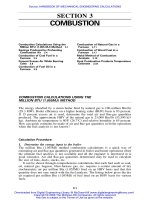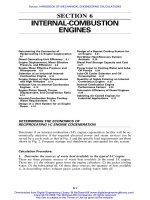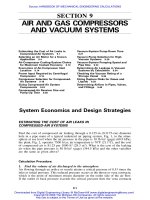- Trang chủ >>
- Khoa Học Tự Nhiên >>
- Vật lý
Handbook of Formulae and Physical Constants pdf
Bạn đang xem bản rút gọn của tài liệu. Xem và tải ngay bản đầy đủ của tài liệu tại đây (634.24 KB, 43 trang )
Handbook of
Formulae and
Physical Constants
For The Use Of Students And Examination Candidates
A
pproved by the Interprovincial Power Engineering
Curriculum Committee and the Provincial Chief
Inspectors' Association's Committee for the
standardization of Power Engineer's Examinations n
Canada.
Duplication of this material for student
in-class use or for examination
purposes is permitted without written
approval.
www.powerengineering.ca
Printed July 2003
Table of Contents
TOPIC PAGE
SI Multiples 1
Basic Units (distance, area, volume, mass, density) 2
Mathematical Formulae 5
Applied Mechanics 10
Thermodynamics 21
Fluid Mechanics 28
Electricity 30
Periodic Table 34
Names in the Metric System
VALUE
EXPONENT
SYMBOL
PREFIX
1 000 000 000 000 10
12
T tera
1 000 000 000 10
9
G giga
1 000 000 10
6
M mega
1 000 10
3
k kilo
100 10
2
h hecto
10 10
1
da deca
0.1 10
-1
d deci
0.01 10
-2
c centi
0.001 10
-3
m milli
0.000 001 10
-6
µ
micro
0.000 000 001 10
-9
n nano
0.000 000 000 001 10
-12
p pico
Conversion Chart for Metric Units
To
Milli-
To
Centi-
To
Deci-
To
Metre,
Gram,
Litre
To
Deca-
To
Hecto-
To
Kilo-
Kilo-
x 10
6
x 10
5
x 10
4
x 10
3
x 10
2
x 10
1
To Convert
Hecto-
x 10
5
x 10
4
x 10
3
x 10
2
x 10
1
x 10
-1
Deca-
x 10
4
x 10
3
x 10
2
x 10
1
x 10
-1
x 10
-2
Metre,
Gram,
Litre
x 10
3
x 10
2
x 10
1
x 10
-1
x 10
-2
x 10
-3
Deci-
x 10
2
x 10
1
x 10
-1
x 10
-2
x 10
-3
x 10
-4
Centi-
x 10
1
x 10
-1
x 10
-2
x 10
-3
x 10
-4
x 10
-5
Milli-
x 10
-1
x 10
-2
x 10
-3
x 10
-4
x 10
-5
x 10
-6
Page 1
BASIC UNITS
SI IMPERIAL
DISTANCE
1 metre (1 m) = 10 decimetres (10 dm) 12 in. = 1 ft
= 100 centimetres (100 cm) 3 ft = 1 yd
= 1000 millimetres (1000 mm) 5280 ft = 1 mile
1760 yd = 1 mile
1 decametre (1 dam) = 10 m
1 hectometre (1 hm) = 100 m
1 kilometre (1 km) = 1000 m
Conversions:
1 in. = 25.4 mm
1 ft = 30.48 cm
1 mile = 1.61 km
1 yd = 0.914 m
1 m = 3.28 ft
Area
1 sq metre (1 m
2
) = 10 000 cm
2
1 ft
2
= 144 in.
2
= 1 000 000 mm
2
1 yd
2
= 9 ft
2
1 sq mile = 640 acre = 1 section
1 sq hectometre (1 hm
2
) = 10 000 m
2
= 1 hectare (1 ha)
1 sq km (1 km
2
) = 1 000 000 m
2
Conversions:
1 in.
2
= 6.45 cm
2
= 645 mm
2
1 m
2
= 10.8 ft
2
1 acre = 0.405 ha
1 sq mile = 2.59 km
2
Page 2
SI IMPERIAL
Volume
1 m
3
= 1 000 000 cm
3
1 ft
3
= 1728 in.
3
= 1 x 10
9
mm
3
1 yd
3
= 27 ft
3
1 dm
3
= 1 litre 1(liquid) U.S. gallon = 231 in.
3
1 litre = 1000 cm
3
= 4 (liquid) quarts
1 mL = 1 cm
3
1 U.S. barrel (bbl) = 42 U.S. gal.
1 m
3
= 1000 litres 1 imperial gallon = 1.2 U.S. gal.
Conversions:
1 in.
3
= 16.4 cm
3
1 m
3
= 35.3 ft
3
1 litre = 61 in.
3
1 U.S.gal = 3.78 litres
1 U.S. bbl = 159 litres
1 litre/s = 15.9 U.S. gal/min
Mass and Weight
1 kilogram (1 kg) = 1000 grams 2000 lb = 1 ton (short)
1000 kg = 1 tonne 1 long ton = 2240 lb
Conversions:
1 kg (on Earth) results in a weight of 2.2 lb
Density
volume
mass
density mass =
volume
weight
densityweight =
⎟
⎠
⎞
⎜
⎝
⎛
=
3
m
kg
V
m
ρ
⎟
⎠
⎞
⎜
⎝
⎛
=
3
ft
lb
V
w
ρ
Conversions:
(on Earth) a mass density of 1
kg
m
3
results in a weight density of 0.0623
lb
f
t
3
Page 3
SI Imperial
RELATIVE DENSITY
In SI R.D. is a comparison of mass density In Imperial the corresponding quantity is
to a standard. For solids and liquids the
specific gravity; for solids and liquids a
standard is fresh water. comparison of weight density to that of
water.
Conversions:
In both systems the same numbers
hold for R.D. as for S.G. since
these are equivalent ratios.
RELATIVE DENSITY (SPECIFIC GRAVITY) OF VARIOUS SUBSTANCES
Water (fresh) 1.00 Mica 2.9
Water (sea average) 1.03 Nickel 8.6
Aluminum 2.56 Oil (linseed) 0.94
Antimony 6.70 Oil (olive) 0.92
Bismuth 9.80 Oil (petroleum) 0.76-0.86
Brass 8.40 Oil (turpentine) 0.87
Brick 2.1 Paraffin 0.86
Calcium 1.58 Platinum 21.5
Carbon (diamond) 3.4 Sand (dry) 1.42
Carbon (graphite) 2.3 Silicon 2.6
Carbon (charcoal) 1.8 Silver 10.57
Chromium 6.5 Slate 2.1-2.8
Clay 1.9 Sodium 0.97
Coal 1.36-1.4 Steel (mild) 7.87
Cobalt 8.6 Sulphur 2.07
Copper 8.77 Tin 7.3
Cork 0.24 Tungsten 19.1
Glass (crown) 2.5 Wood (ash) 0.75
Glass (flint) 3.5 Wood (beech) 0.7-0.8
Gold 19.3 Wood (ebony) 1.1-1.2
Iron (cast) 7.21 Wood (elm) 0.66
Iron (wrought) 7.78 Wood (lignum-vitae) 1.3
Lead 11.4 Wood (oak) 0.7-1.0
Magnesium 1.74 Wood (pine) 0.56
Manganese 8.0 Wood (teak) 0.8
Mercury 13.6 Zinc 7.0
Page 4
Greek Alphabet
Alpha α Iota ι Rho ρ
Beta
β Kappa κ Sigma Σ, σ
Gamma
γ Lambda λ Tau τ
Delta
∆ Mu µ Upsilon υ
Epsilon
ε Nu ν Phi Φ, φ
Zeta
ζ Xi ξ Kai χ
Eta η Omicron Ο Psi ψ
Theta θ Pi π Omega Ω, ω
MATHEMATICAL FORMULAE
Algebra
1. Expansion Formulae
(x + y)
2
= x
2
+ 2xy + y
2
(x - y)
2
= x
2
- 2xy + y
2
x
2
- y
2
= (x - y) (x + y)
(x + y)
3
= x
3
+ 3x
2
y + 3xy
2
+ y
3
x
3
+ y
3
= (x + y) (x
2
- xy + y
2
)
(x - y)
3
= x
3
- 3x
2
y + 3xy
2
- y
3
x
3
- y
3
= (x - y) (x
2
+ xy + y
2
)
2. Quadratic Equation
If ax
2
+ bx + c = 0,
Then x =
2a
ac4b b-
2
−±
Page 5
Trigonometry
1. Basic Ratios
h
y
A Sin
= ,
h
x
A cos
= ,
x
y
A tan
=
2. Pythagoras' Law
x
2
+ y
2
= h
2
3. Trigonometric Function Values
Sin is positive from 0° to 90° and positive from 90° to 180°
Cos is positive from 0° to 90° and negative from 90° to 180°
Tan is positive from 0° to 90° and negative from 90° to 180°
4. Solution of Triangles
a. Sine Law
CSin
c
BSin
b
A Sin
a
==
b. Cosine Law
c
2
= a
2
+ b
2
- 2 ab Cos C
a
2
= b
2
+ c
2
- 2 bc Cos A
b
2
= a
2
+ c
2
- 2 ac Cos B
Page 6
Geometry
1. Areas of Triangles
a. All Triangles
2
heightlar perpendicu x base
Area
=
Area
2
BSin ac
2
CSin ab
2
ASin bc
===
and,
c) - (s b) - (s a)-(s s Area =
where, s is half the sum of the sides, or s =
2
c b a
+
+
b. Equilateral Triangles
Area = 0.433 x side
2
2. Circumference of a Circle
C = πd
3. Area of a Circle
A = πr
2
=
2
r x ncecircumfere
=
2
d
4
π
= 0.7854d
2
4. Area of a Sector of a Circle
A =
2
r x arc
A =
2
r x π
360
θ
°
(θ = angle in degrees)
A =
2
rθ
2
°
(θ = angle in radians)
Page 7
5. Area of a Segment of a Circle
A = area of sector – area of triangle
Also approximate area =
0.608-
h
d
h
3
4
2
6. Ellipse
A =
Dd
4
π
Approx. circumference =
()
2
d D
π
+
7. Area of Trapezoid
A =
h
2
b a
⎟
⎠
⎞
⎜
⎝
⎛
+
8. Area of Hexagon
A = 2.6s
2
where s is the length of one side
9. Area of Octagon
A = 4.83s
2
where s is the length of one side
10. Sphere
Total surface area A =4πr
2
Surface area of segment A
s
= πdh
Volume V =
3
r π
3
4
Volume of segment
V
s
=
πh
2
3
(3r – h)
V
s
=
πh
6
(h
2
+3a
2
) where a = radius of segment
b
ase
Page 8
11. Volume of a Cylinder
V =
Ld
4
π
2
where L is cylinder length
12. Pyramid
Volume
V =
3
1
base area x perpendicular height
Volume of frustum
V
F
= )Aa a (A
3
h
++ where h is the perpendicular height, A and a are areas as shown
13. Cone
Area of curved surface of cone:
A =
2
DL π
Area of curved surface of frustum
A
F
=
2
d)L (D π
+
Volume of cone:
V=
b
ase are
a
× perpendicula
r
height
3
Volume of frustum:
V
F
=
perpendicula
r
height ×π(R
2
+
r
2
+R
r
)
3
Page 9
APPLIED MECHANICS
Scalar - a property described by a magnitude only
Vector - a property described by a magnitude and a direction
Velocity - vector property equal to
displacemen
t
time
The magnitude of velocity may be referred to as
speed
In SI the basic unit is
m
s
, in Imperial
f
t
s
Other common units are
km
h
,
mi
h
Conversions:
s
ft
3.28
s
m
1
=
h
mi
0.621
h
km
1
=
Speed of sound in dry air is 331
m
s
at 0°C and increases by about 0.61
m
s
for each °C
rise
Speed of light in vacuum equals 3 x 10
8
m
s
Acceleration - vector property equal to
change in velocity
time
In SI the basic unit is
2
s
m
, in Imperial
2
s
ft
Conversion: 1
2
s
m
= 3.28
2
s
ft
Acceleration due to gravity, symbol "g", is 9.81
2
s
m
or 32.2
2
s
ft
Page 10
LINEAR VELOCITY AND ACCELERATION
u initial velocity
v final velocity
t elapsed time
s displacement
a acceleration
v=u+a
t
s=
v+u
2
t
s = ut +
1
2
at
2
v
2
=u
2
+2as
Angular Velocity and Acceleration
θ angular displacement (radians)
ω angular velocity (radians/s); ω
1
= initial, ω
2
= final
α angular acceleration (radians/s
2
)
ω
2
= ω
1
+ α t
θ =
ω
1
+ ω
2
x t
2
θ = ω
1
t + ½
α t
2
ω
2
2
= ω
1
2
+ 2 α θ
linear displacement, s = r θ
linear velocity, v = r ω
linear, or tangential acceleration, a
T
= r α
Page 11
Tangential, Centripetal and Total Acceleration
Tangential acceleration a
T
is due to angular acceleration α
a
T
=
r
α
Centripetal (Centrifugal) acceleration a
c
is due to change in direction only
a
c
= v
2
/r = r ω
2
Total acceleration, a, of a rotating point experiencing angular acceleration is the vector sum
of a
T
and a
c
a = a
T
+ a
c
FORCE
Vector quantity, a push or pull which changes the shape and/or motion of an object
In SI the unit of force is the newton, N, defined as a
kg m
s
2
In Imperial the unit of force is the pound lb
Conversion: 9.81 N = 2.2 lb
Weight
The gravitational force of attraction between a mass, m, and the mass of the Earth
In SI weight can be calculated from
Weight = F = mg , where g = 9.81 m/s
2
In Imperial, the mass of an object (rarely used), in slugs, can be calculated from the known
weight in pounds
m=
Weigh
t
g
g=32.2
ft
s
2
Page 12
Newton's Second Law of Motion
An unbalanced force F will cause an object of mass m to accelerate a, according to:
F = ma (Imperial F =
w
g
a, where w is weight)
Torque Equation
T = I α where T is the acceleration torque in Nm, I is the moment of inertia in kg m
2
and α is the angular acceleration in radians/s
2
Momentum
Vector quantity, symbol p,
p = mv (Imperial p =
w
g
v, where w is weight)
in SI unit is
kg m
s
Work
Scalar quantity, equal to the (vector) product of a force and the displacement of an object. In
simple systems, where W is work, F force and s distance
W = F s
In SI the unit of work is the joule, J, or kilojoule, kJ
1 J = 1 Nm
In Imperial the unit of work is the ft-lb
Energy
Energy is the ability to do work, the units are the same as for work; J, kJ, and ft-lb
Page 13
Kinetic Energy
Energy due to motion
E
k
=
1
2
mv
2
In Imperial this is usually expressed as
E
k
=
w
2g
v
2
where w is weight
Kinetic Energy of Rotation
22
R
ωmk
2
1
E
= where k is radius of gyration, ω is angular velocity in rad/s
or
2
R
Iω
2
1
E
= where I = mk
2
is the moment of inertia
CENTRIPETAL (CENTRIFUGAL) FORCE
r
mv
F
2
C
= where r is the radius
or
F
C
= m ω
2
r where ω is angular velocity in rad/s
Potential Energy
Energy due to position in a force field, such as gravity
E
p
= m g h
In Imperial this is usually expressed E
p
= w h where w is weight, and h is height above some
specified datum
Page 14
Thermal Energy
In SI the common units of thermal energy are J, and kJ, (and kJ/kg for specific quantities)
In Imperial, the units of thermal energy are British Thermal Units (Btu)
Conversions: 1 Btu = 1055 J
1 Btu = 778 ft-lb
Electrical Energy
In SI the units of electrical energy are J, kJ and kilowatt hours kWh. In Imperial, the unit of
electrical energy is the kWh
Conversions: 1 kWh = 3600 kJ
1 kWh = 3412 Btu = 2.66 x 10
6
ft-lb
Power
A scalar quantity, equal to the rate of doing work
In SI the unit is the Watt W (or kW)
1W=1
J
s
In Imperial, the units are:
Mechanical Power -
f
t
–lb
s
, horsepower h.p.
Thermal Power -
Btu
s
Electrical Power - W, kW, or h.p.
Conversions: 746 W = 1 h.p.
1 h.p. = 550
f
t
–lb
s
1 kW = 0.948
Btu
s
Page 15
Pressure
A vector quantity, force per unit area
In SI the basic units of pressure are pascals Pa and kPa
1Pa=1
N
m
2
In Imperial, the basic unit is the pound per square inch, psi
Atmospheric Pressure
At sea level atmospheric pressure equals 101.3 kPa or 14.7 psi
Pressure Conversions
1 psi = 6.895 kPa
Pressure may be expressed in standard units, or in units of static fluid head, in both SI and
Imperial systems
Common equivalencies are:
1 kPa = 0.294 in. mercury = 7.5 mm mercury
1 kPa = 4.02 in. water = 102 mm water
1 psi = 2.03 in. mercury = 51.7 mm mercury
1 psi = 27.7 in. water = 703 mm water
1 m H
2
O = 9.81 kPa
Other pressure unit conversions:
1 bar = 14.5 psi = 100 kPa
1 kg/cm
2
= 98.1 kPa = 14.2 psi = 0.981 bar
1 atmosphere (atm) = 101.3 kPa = 14.7 psi
Page 16
Simple Harmonic Motion
Velocity of P =
s
m
x- R ω
22
Acceleration of P = ω
2
x m/s
2
The period or time of a complete oscillation =
ω
π2
seconds
General formula for the period of S.H.M.
T = 2π
onaccelerati
ntdisplaceme
Simple Pendulum
T = 2π
g
L
T = period or time in seconds for a double swing
L = length in metres
The Conical Pendulum
R/H = tan θ= F
c
/W = ω
2
R/g
Page 17
Lifting Machines
W = load lifted, F = force applied
M.A. =
effor
t
load
=
F
W
V.R. (velocity ratio) =
distance loa
d
distanceeffort
η = efficiency =
V.R.
M.A.
1. Lifting Blocks
V.R. = number of rope strands supporting the load block
2. Wheel & Differential Axle
Velocity ratio =
2
)r -(r π2
Rπ2
1
=
1
r -r
2R
2 R
Or, using diameters instead of radii,
Velocity ratio =
)d - (d
2D
1
3. Inclined Plane
V.R. =
height
length
4. Screw Jack
V.R. =
threadofpitch
leverage of ncecircumfere
Page 18
Indicated Power
I.P. = P
m
A L N where I.P. is power in W, P
m
is mean or "average" effective pressure in
Pa, A is piston area in m
2
, L is length of stroke in m and N is number of
power strokes per second
Brake Power
B.P. = Tω where B.P. is brake power in W, T is torque in Nm and ω is angular
velocity in radian/second
STRESS, STRAIN and MODULUS OF ELASTICITY
Direct stress =
A
P
area
load
=
Direct strain =
L
length original
extension
A
∆
=
Modulus of elasticity
E =
AA ∆
=
∆
=
A
PL
L
/
P/A
straindirect
stressdirect
Shear stress τ =
shea
r
under area
force
Shear strain =
L
x
Modulus of rigidity
G =
strainshear
stressshear
Page 19
General Torsion Equation (Shafts of circular cross-section)
T
J
=
τ
r
=
G
θ
L
)d (d
32
π
)r - (r
2
π
J
32
πd
r
2
π
J
4
2
4
1
4
2
4
1
4
4
−=
=
==
Shaft HollowFor 2.
Shaft SolidFor 1.
T = torque or twisting moment in newton metres
J = polar second moment of area of cross-section
about shaft axis.
τ = shear stress at outer fibres in pascals
r = radius of shaft in metres
G = modulus of rigidity in pascals
θ = angle of twist in radians
L = length of shaft in metres
d = diameter of shaft in metres
Relationship Between Bending Stress and External Bending Moment
M
I
=
σ
y
=
E
R
1. For Rectangle
M = external bending moment in newton metres
I = second moment of area in m
4
σ = bending stress at outer fibres in pascals
y = distance from centroid to outer fibres in metres
E = modulus of elasticity in pascals
R = radius of currative in metres
I =
12
BD
3
2. For Solid Shaft
I=
πD
4
6
4
Page 20
THERMODYNAMICS
Temperature Scales
°
)32F (
9
5
C −°= °F = 32 C
5
9
+°
°R = °F + 460 (R Rankine) K = °C + 273 (K Kelvin)
Sensible Heat Equation
Q = mc∆T
m is mass
c is specific heat
∆T is temperature change
Latent Heat
Latent heat of fusion of ice = 335 kJ/kg
Latent heat of steam from and at 100°C = 2257 kJ/kg
1 tonne of refrigeration = 335 000 kJ/day
= 233 kJ/min
Gas Laws
1. Boyle’s Law
When gas temperature is constant
PV = constant or
P
1
V
1
= P
2
V
2
where P is absolute pressure and V is volume
2. Charles’ Law
When gas pressure is constant,
constant
T
V
=
or
V
1
T
1
=
V
2
T
2
, where V is volume and T is absolute temperature
Page 21
3. Gay-Lussac's Law
When gas volume is constant,
constant
T
P
=
Or
2
2
1
1
T
P
T
P
= , where P is absolute pressure and T is absolute temperature
4. General Gas Law
P
1
V
1
T
1
=
P
2
V
2
T
2
= constant
P V = m R T where P = absolute pressure (kPa)
V = volume (m
3
)
T = absolute temp (K)
m = mass (kg)
R = characteristic constant (kJ/kgK)
Also
PV = nR
o
T where P = absolute pressure (kPa)
V = volume (m
3
)
T = absolute temperature K
N = the number of kmoles of gas
R
o
=
the universal gas constant 8.314 kJ/kmol/K
SPECIFIC HEATS OF GASES
Specific Heat at Specific Heat at Ratio of Specific
Constant Pressure Constant Volume Heats
kJ/kgK kJ/kgK γ = c
p
/
c
v
GAS or or
kJ/kg
o
C kJ/kg
o
C
Air 1.005 0.718 1.40
Ammonia 2.060 1.561 1.32
Carbon Dioxide 0.825 0.630 1.31
Carbon Monoxide 1.051 0.751 1.40
Helium 5.234 3.153 1.66
Hydrogen 14.235 10.096 1.41
Hydrogen Sulphide 1.105 0.85 1.30
Methane 2.177 1.675 1.30
Nitrogen 1.043 0.745 1.40
Oxygen 0.913 0.652 1.40
Sulphur Dioxide 0.632 0.451 1.40
Page 22









